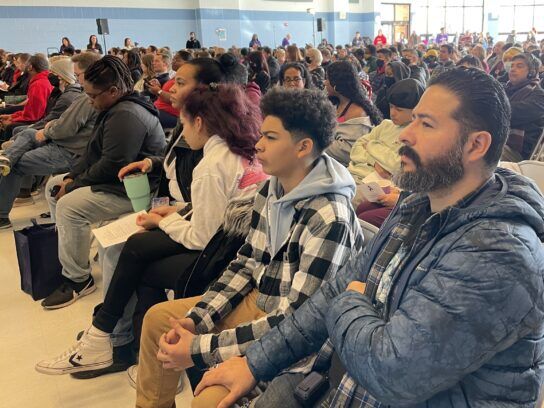This article is part of the WTOP series, “Facing Down Fentanyl: Teens Confront Drug Danger.”
The fentanyl epidemic has created new challenges for school systems across the country.
Students are overdosing — sometimes on school grounds — in higher numbers, and school systems are racing to respond by stocking up on overdose-reversing antidotes and coming up with ways to support students’ mental health better. School systems in the D.C. region, including in Montgomery County, Maryland, are also tightening up policies when it comes to responding to overdoses on campuses.
“What’s happening in Montgomery County is not different from what is happening in other counties close by and really across the nation — and it’s all very concerning,” said Patricia Kapunan, the school system’s medical officer.
In 2022, Montgomery County saw 11 school-aged young people die from opioid overdoses — more than double the 2021 total of five deaths. None of the fatal overdoses occurred on school grounds.
The county also saw a 68% increase in nonfatal overdoses between 2021 and 2022, with 37 overdoses involving people 21 and younger, according to Montgomery County police data.
Kapunan said so far this school year, 15 students have been given the overdose-reversing drug naloxone because of a suspected overdose. She said in all but one case, a school nurse administered the Narcan.
Kapunan said the school system began stocking all schools with Narcan, the brand name for naloxone, starting in the 2018-2019 school year. Schools have also rolled out emergency response plans for suspected overdoses.
Read more from the series “Facing Down Fentanyl: Teens Confront Drug Danger”
- Unseen and unheard: Unique Maryland high school aims to help students beat addiction
- The small blue pills behind a surge in children’s fentanyl-related hospital visits in the DC area
- ‘Not my child:’ What a mother says you need to know about teens and fentanyl
Working to tighten new policy
The school system is also working to formalize its first policy specifically tailored around how to use naloxone. Once completed, Kapunan said, the new policy will help guide school officials, teachers and students on how to respond to suspected overdoses. For example, can someone who has their own personal supply of naloxone — such as a teacher or another student — administer it during a suspected overdose? Will staff members be liable for anything as first responders?
“That level of detail for schools (is something) we haven’t had,” Kapunan said.
Beyond its focus on teaching staff about responding to overdoses, the school looks to focus on prevention by approaching substance use from a “wide lens of mental health prevention,” according to Kapunan. That focus comes amid a rise in mental health issues seen in students since the start of the pandemic.
“How we talk about and support each other so we can detect early when someone is struggling, and we can intervene way before it gets to a situation in which you may be using substances as one way to cope,” she said.
The school system said education about the risks of drugs is an important part of the conversation since students make better decisions when they understand the risks. She said students also want to learn how they can help their peers.
“We have found that empowering and educating teens has led to more questions, more interest, more energy, and not less,” Kapunan said.
Honest conversations
The school system has found that smaller forums catering to specific grades work better than big assemblies in school auditoriums.
“The questions that you know, a middle schooler might ask is very different from a ninth grader or a senior,” she said.
Also, allowing for smaller forums only open to parents allows for a more open and honest conversation. Those forums include information on spotting an overdose. Parents are also urged to, in addition to learning how to use naloxone, stock their home with the overdose reversal drug.
Another strategy is giving not only teachers but parents and students a way to notify the school of a student who may be in need. Kapunan said all high schools have “core well-being” teams, which anyone can refer a student to. The team will then check in with the students to see what help they need.

Kapunan said one area where more help is needed as a community is additional recovery options for teenagers who are struggling with a substance use disorder.
“We don’t have enough treatment services, especially residential and intensive treatment services that also serve people with both mental health and substance use,” she said.
Another problem for families seeking help for a child with a dangerous addiction is many services don’t always take common insurance, leaving some families unable to afford the proper health their child may need.
Montgomery County Public Schools has partnered with Sheppard Pratt Health System to offer a program that helps students get academic and recovery support in the same place, but Kapunan said the students need to get through treatment first and get to a place where they are comfortable receiving help.
“If someone is actively struggling … it’s already challenging to come forward for treatment,” she said. “But then if the treatment is not there, and you don’t know how to get there, that’s a real problem.”
Montgomery Goes Purple
As schools address overdoses and illicit drug use head-on, they are collaborating with outside groups to help educate the community about the dangers of the substances and how a person using them can get help.
“We’re seeing a lot of overdoses from students getting a hold of pills,” said Laura Mitchell, co-founder of the group Montgomery Goes Purple.
The organization is a partnership between schools, local government and other community organizations. It leads forums to help educate the community about the dangers of fentanyl and provide information on how to help someone battling addiction.
Mitchell said that many kids see and use both prescribed and over-the-counter pills legally in everyday life, and that could lead to a misconception that pills from the streets — such as fake oxycodone pills known as M-30s — are safe to try, though they are far from it.
Addiction “hijacks your brain and says, ‘I’ve got to have that or I’m going to make you really, really sick,’” Mitchell said.
Montgomery Goes Purple focuses on teaching parents about how best to begin conversations with their children about substance use, which she said includes honest and frequent conversations. There is also guidance for kids afraid to open up to their parents about their substance use disorder.
“If you find someone unconscious, unresponsive, and you don’t know why, it’s safe to give them Narcan,” Mitchell said. “Even if it’s not an opioid overdose … it doesn’t hurt them.”
The group also helps families tackle hurdles that many face with insurance companies when paying for recovery programs and offers training on using naloxone.
Mitchell said it is also important for parents and teens facing addiction to know that there are multiple recovery options, and one size does not fit all.
“Just because one didn’t work doesn’t mean the next one won’t, or the third or the fifth one won’t,” Mitchell said.








